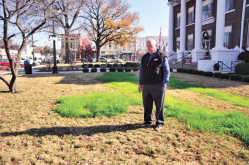JUNCTION CITY, Kan. (WIBW) -- Nearly 60 years after serving in combat, a local veteran is being recognized for his efforts to defend our country during the Korean War.
Donald Hamilton is a proud recipient of a medal that recognizes Korean War veterans.
The Junction City resident was a military policeman who served in Taejon, Korea from April of 1953 to May of 1955. He joined the Army at the age of 17 and served three years, part of which was spent in Korea.
"I was a train guard commander. We guarded the trains and made them secure to make sure that the supplies got there," he said.
He oversaw the transportation of prisoners, supplies, fuel tanks and troops.
Hamilton’s military records were later destroyed in a fire and had to be reconstructed but he met the qualifications for the Korea Defense Service Medal, a military award that was first created in 2002 when it was signed into law by President George W. Bush. In 2004, the Institute of Heraldry approved the final design and the medal became authorized for distribution.
"I had all these other medals that I got when I was in Korea and I thought I had all of them but then they came up with this new one and I applied for it but never could get it until now. And I know a lot of other people that applied for it but they couldn’t get it because they didn’t meet the qualifications but I did," Hamilton explained.
The Korea Defense Service Medal is authorized for those members of the United States Armed Forces who have served duty in South Korea after the signing of the Korean Armistice Agreement in support of the defense of the Republic of Korea.
He was presented with the medal during an official ceremony at the American Legion on December 21, 2012.
"I applied for it three times and I couldn’t get it because my records had been burned in a fire at Fort Harrison, Indiana... Then, I opened the mail one morning and there was that medal. I’m surprised and not only that, I appreciate it. I really appreciate hearing from the government 59 years later and getting the medal," Hamilton told WIBW.
After the Army, Hamilton policed in Riley and Geary County and later became the president of Fort Riley Credit Union and local farmer in the Junction City area.
Now 79, he says he’s done everything that he wanted to do in life and that includes the time he spent defending his nation. Hamilton's Korea Defense Service Medal sits on his mantelpiece at home as a constant reminder that his service did not go unrecognized.




